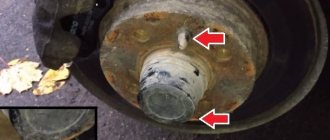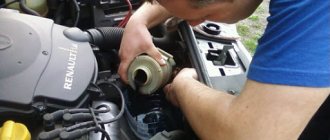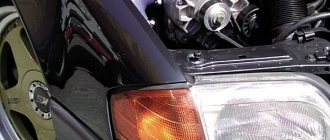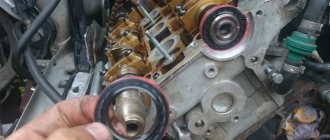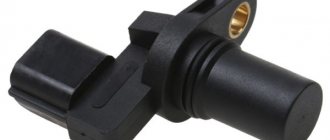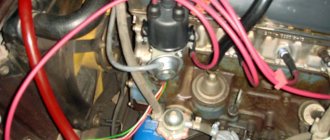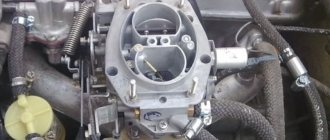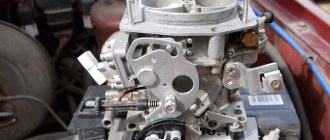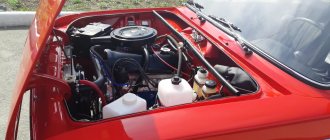The main problem that arises with the carburetor is clogging due to low-quality fuel. Engine operation may be disrupted, and this manifests itself in the following moments:
- the car will be unstable when idling;
- power will decrease;
- toxicity of gases increases;
- fuel consumption increases;
- When accelerating a car, “failures” occur.
Also, the reason may be a clogged air filter, for this reason air enters in insufficient quantities, this will lead to a deterioration in the quality of the mixture. One of the main reasons is cheap fuel. Many drivers use it to save money, but this can only harm their car.
Cleaning the carburetor on a car without removing it
Carburetor injection, being an outdated system compared to an injector, is still a fairly common internal combustion engine power supply scheme. Today, carburetors are found mainly on domestically produced cars and old foreign cars, which continue to be actively used in the CIS. Quite common malfunctions that a driver may encounter are cases when a carburetor car has a problem with idling, the engine does not start, is unstable or stalls when driving, in transient modes, etc. There are also jerks, failures during acceleration, the engine runs rough and consumes a lot of fuel.
In other words, it is impossible to continue driving the car. The reason is the need to clean the carburetor, which tends to become clogged over time. In this article we will talk about how you can clean the carburetor and how to clean the carburetor without removing it from the car. This can be especially useful when cleaning the carburetor is urgently needed in the field, the machine is located far from service centers, etc.
Liquids poured into the tank
In the auto chemicals department you can find many jars and containers designed specifically for cleaning carburetors. Typically the volume of such bubbles is about 150 ml. The contents of these containers are poured into the tank before refueling the car and are completely consumed until the light indicates that the reserve balance is zero. Manufacturers of these products claim that the liquids will help:
- get rid of dirt and deposits;
- increase engine starting efficiency;
- reduce the toxicity of exhaust gases;
- save on fuel.
It is recommended to clean with these liquids once every 13-15 thousand km. It depends on what kind of fuel the car is fueled with.
How to properly clean a carburetor without removing it
First of all, every owner of a carburetor car must have and always carry with him a special aerosol spray for cleaning the carburetor (the so-called “carb cleaner”). In some cases, it is enough to simply remove the air filter cover and spray carburetor cleaner on the device, after which engine operation returns to normal. Note that this approach does not always help to clean the carburetor channel, but sometimes it gives results. Let's look at this cleaning in more detail.
- In addition to the above aerosol can with a cleaning composition, you will need keys to remove the air filter cover;
- After removing the filter housing, you may need to unscrew the carburetor solenoid valve or the fuel jet holder plug responsible for the idle mode (which depends on the design of the metering device);
- After unscrewing, we gain access to the hole in the carburetor cover. Through this hole, the cleaner can be supplied to clean the channels of the idle system, as well as the transition system of the first chamber.
- In parallel, the carbicleaner should be sprayed into the first and second chambers, and also injected into the holes of the channels of the air jets of the GDS (main dosing system).
- The correct application of an aerosol is considered to be when the product is applied to the walls of the chambers themselves and diffusers, and the air and throttle valves are also treated. The nozzle in the form of a thin tube that comes with the cleaner can allows you to treat the most difficult to reach elements.
- Additionally, you should spray the cleaner where in the carburetor there is an air damper drive lever and a throttle valve drive for the first chamber, other levers and accessible drive elements. This removes dirt from the controls, allowing the carburetor injection to function properly.
- After applying the cleaner, you must pause for about 5 minutes. During this time, the product softens deposits and washes away dirt;
- The engine can now be started. After starting, by pulling out the “choke” handle (this will allow the engine to idle without a solenoid valve), you should also accelerate a little.
- Some drivers also forcibly increase the speed above idle, after which, with the engine running at higher speeds, they additionally spray cleaner into the carburetor chambers, into the openings of the air channels of the gas pump, as well as into the installation site of the solenoid valve;
- After this, you can gas again, then the cleaning procedure is repeated 2-3 times. The final stage can be considered the installation of the solenoid valve or plug in place, after which the suction handle retracts.
Express cleaning methods
The process of blowing and cleaning the parts of a Solex carburetor with your own hands is a long and labor-intensive task, so the question of how to clean a VAZ 2109 carburetor without removing it is relevant for most owners of nines.
For quick washing without dismantling, various auto chemicals are used - the so-called “liquid cleaning”. Sold in cans of 300-500 ml. Some products are designed to be poured into a tank. You need to fill the product with a small amount of gasoline remaining and drive until the fuel runs out. Repeat the procedure after 5-7 thousand km. After first use, clean the gas tank as a preventative measure.
Another group of products is intended for “local” use. The air filter is dismantled and the aerosol from the can is pumped directly through the tubes of the device. After this, you need to start the engine and let the car idle. These products are not a panacea for a heavily contaminated carburetor, but only help in the aspect of prevention and removal of minor contaminants. Even with regular use of this auto chemical, cleaning the carburetor of the VAZ 2109 should be carried out at least three times a year.
What's the result?
Taking into account all of the above, it becomes clear that even with the relative simplicity of the design, the carburetor still needs timely additional care. To maintain the cleanliness and performance of the device, some experts recommend cleaning and adjusting the carburetor at least twice a year. It is recommended to do this in the off-season, that is, before the onset of severe frost or heat. This measure allows you to maintain fuel consumption at an optimal level.
If noticeable dips are noted when pressing the gas pedal, then, in parallel with cleaning the carburetor itself, remove the carburetor cover, after which you need to pay attention to the accelerator pump nozzle. This element should be thoroughly cleaned using a carbicleaner; additionally, you can blow it with air under pressure from a compressor.
In other situations, it is better to disassemble and clean the dosing device at the first opportunity. This statement is also true if the carburetor is very dirty for some reason or has never been cleaned before.
Various types of available carburetor cleaning products and compositions, advantages and disadvantages. How to properly clean a carburetor, which cleaner is better.
What does the color of carbon deposits on a spark plug indicate, and why does carbon deposits of one color or another form? How to clean spark plugs from carbon deposits with your own hands, tips.
Why do you need to clean the throttle valve periodically? How to clean the throttle valve, training and adaptation of the throttle valve after cleaning, useful tips.
Refinement and modernization of the carburetor. The main disadvantages of the carburetor injection system and how to eliminate them, settings. Intake manifold tuning.
The main reasons that lead to a lean mixture. A lean mixture on carburetor and injection internal combustion engines, as well as on engines with gas equipment. Diagnostics, repair.
Why is it necessary to clean the fuel pump mesh? When is it better to change and how to clean the fuel pump mesh? How to properly remove the fuel pump, subtleties and nuances.
Source
Scheduled preventive cleaning
It is known that the best repair is timely prevention. Car owners should pay close attention to keeping the carburetor properly clean. Try to refuel at proven gas stations, use only the brands of fuel specified in the operating documentation. From time to time it is useful to carry out routine preventative cleaning of the unit yourself. Auto chemical manufacturers produce special compounds for such cleaning.
A standard plastic bottle of this composition, with a volume of 350–500 ml, is poured into an almost empty tank before refilling until the tank is full. The additive is mixed with gasoline and begins to clean the engine fuel system. It dissolves and removes tar deposits, carbon deposits and other contaminants from the carburetor. The additive also has a positive effect on the condition of pipelines and the fuel pump. It is recommended to leave the tank as full as possible so that the next time you fill up, the concentration of the additive in the fuel is minimal.
The most famous manufacturers of carburetor additives are Hi-Gear, Liqui Moly, 3M, and the domestic brand “Edial” is actively promoting on the market. Additives should only be purchased from reliable suppliers. Those who happen to buy a counterfeit product often deny the benefits of additives altogether.
On average, it is recommended to add the additive to every twentieth full tank of fuel.
Quick repair and precise adjustment of VAZ 2108/2109 carburetors: instructions and tips
One of the most common models in the country produced by AvtoVAZ can be considered the “eight” or its modification, the “nine”. Owners of VAZ 2108/2109 cars have been convinced in practice of the performance of their vehicles and their ease of maintenance. In order to prevent any malfunctions in the operation of the machine in a timely manner, you need to carefully monitor its technical condition. One of the main tasks of the driver is to control the operation of the carburetor device on the VAZ. The car owner can perform almost all types of repairs and adjustments with his own hands, since the carburetor design has a simple structure.
Models of carburetors for VAZ 2108/2109
Carburetor mechanisms of the Solex series are produced at the Dimitrovgrad Automotive Accessory Plant. The designs are intended for use with front-wheel drive VAZ vehicles, in which the engine unit is located transverse to the body.
The standard model for equipping the VAZ 2108/2109 is the DAAZ 2108–1107–10 carburetor. It is paired with a 1.3-liter engine. Carburetors 21083–1107010 are installed on 1.5 liter engines.
Modern equipment of the VAZ 2108/2109 is provided by carburetors of more advanced models, since they are equipped with a starting device in automatic mode:
- modification 21083–1107010–31 has one stage of automatic control and start in a given mode;
- modification 21083–1107010–35 is equipped with two stages of air damper control, which ensures more stable operation of the power unit;
- modification 21083–1107010–62 is similar to the previous version of the carburetor mechanism, but has the addition of an electrical air-fuel mixture mixing system.
Solex design
The carburetor mechanism of all modifications on the VAZ 2108/2109 is emulsion and consists of two internal combustion chambers. At the top of the carburetor there is a cover that prevents dirt from entering the cavity of the device, and fittings - fuel lines are supplied to them. The middle part is the body itself, into which diffusers and cameras are mounted. At the bottom of the carburetor are the float chamber and throttle valves.
The key elements of the system are:
- accelerator pump;
- float;
- throttle thrust;
- forced idle economizer;
- main dosing system;
- trigger mechanism;
- econostat;
- vehicle idle system.
The principle of operation of the Solex carburetor is that gasoline is supplied through the inlet valve in the fitting. The fuel is directed directly into the float chamber. The fuel level in the cavity must always be at a certain level to avoid dips and jerks in engine operation. Level control is carried out through the movements of a needle valve mechanism.
After the chamber, gasoline is sent to emulsion wells, where it is supplied in strictly limited quantities through fuel nozzles. It is in the wells that air flows break up large drops of gasoline, forming a single air-fuel mixture with it.
The mixture is supplied to diffusers, and through them to the power unit device. Thus, the main task of the carburetor is to form the air-fuel mixture in the desired consistency and direct it to the engine.
Carburetor repair VAZ 2108/2109
Repairing VAZ 2108 and 2109 carburetors is impossible without disassembling the device into individual elements. In this case, the main tasks during disassembly are cleaning (rinsing) each element and replacing failed parts with new ones.
When performing repair work yourself, it is recommended to buy a repair kit designed for VAZ 2108 and 2109 cars. It usually includes all types of sealing gaskets, new jets, as well as diaphragms for the accelerator pump and starter. These are the most necessary elements that quickly wear out or fail, so it is advisable to change them every time the carburetor is disassembled.
Tuning carburetor engine VAZ 2108 1.3 l.
Modification of this unit is not as common as tuning 21083 1.5 due to the lack of meaning; all other things being equal, the 083 engine will always be ahead, it initially has greater volume, power, torque and huge potential for modifications at the same or lower costs. Occasionally, boring for a 79 mm piston is practiced, resulting in a volume of 1.4 liters, but the walls will be very thin, overheating is possible, and accordingly the service life is sharply reduced. The simplest and most inexpensive tuning of a 2108 1.3 engine is to buy a 21083 1.5 l engine or block 083 and finish it to the desired level.
Boring the VAZ 2108 engine and how to boost it correctly
The option of obtaining a volume of 1.4 liters is practiced. installation of Kalinovsky pistons 76.5 and Kalinovsky crankshaft 75.6, connecting rods from the same with shrinkage of 2.3 mm. Cylinder head from 083 or 16 valves from Kalina. On the shafts, intake and exhaust the car will go faster than the new Priora.
Injector for VAZ 2108 engine
On a car with a 1.3 engine, you can install an injector from a 1.5 liter 21083, everything will work on standard firmware.
Pros and cons
Taking into account the characteristics of the engine, in particular the small volume of 1.3 liters, immediately after launch into production the following shortcomings were revealed:
- leaks through the block cover gasket - the error has not been corrected;
- Solex carburetor - required frequent adjustment of the idle modes;
- pump - intensive wear of polymer blades.
Since the 2108 engine was the first with a transverse arrangement under the hood of a car, the default exhaust manifold changed its design in comparison with previous generations of AvtoVAZ internal combustion engines. However, the intake manifold remained the same.
Preparing to blow and flush the carburetor
What do we need to clean the carburetor of a VAZ without resorting to the services of a car service center? First, the car owner must understand which elements and chambers of the unit are subject to purging and cleaning.
Jet location
Most often, the problem can be solved by correcting deficiencies in:
- jets;
- sealing gaskets;
- diaphragms of the accelerator pump and trigger mechanism.
To wash and blow out the carburetor with your own hands, the car owner will need:
- dry and clean rags (during the cleaning process, no lint should fly off the rag);
- toothpicks and cotton swabs;
- washing spray (suitable for all types of devices, including Solex);
- a set of screwdrivers and wrenches for removing parts;
- container for technical liquids;
- personal protective equipment - rubber gloves and goggles.
Before cleaning the carburetor, you need to prepare a work area: it should be a dry, level, illuminated area, since blowing and cleaning often entails the loss of small parts.
How to flush a carburetor assembly without disassembling it
Flushing the Solex carburetor is recommended by the manufacturer in cases where there are clearly any problems with its operation: increased gasoline consumption, jerks and jolts when driving, unstable idle speed, problems with starting.
The traditional method of washing carburetors is to completely disassemble them into individual components, which is not always possible for an inexperienced VAZ owner to do. To simplify the procedure, a technique was created for washing and cleaning the carburetor without disassembling it into components. This technique is based on the use of special aerosols in cans. The most affordable carburetor cleaners are considered to be aerosols produced by ABRO and Mannol - they can be bought at any auto store for 100–150 rubles.
These cleaners do an excellent job of cleaning carburetor mechanisms, and they are also very easy to use. To flush the Solex carburetor, it is recommended to turn off the engine, let it cool and begin the procedure:
- Remove the air filter box from the car and place it to the side.
- Unscrew the solenoid valve from the carburetor body.
- Place a special narrow nozzle on the aerosol can and spray the liquid on the nozzle channels, the first and second chambers, dampers and all visible elements of the carburetor.
- After this, spray the aerosol on the external parts of the mechanism.
- Wait 5–8 minutes (depending on the aerosol manufacturer’s recommendations). During this time, the liquid will be able to corrode accumulations of soot and dirt.
- Next, you can start the engine so that it removes all remaining dirt.
- If during one procedure the carburetor did not have time to be properly cleaned, then you can treat it again with the same aerosol.
After such cleaning, the VAZ 2108/2109 will significantly increase its dynamic characteristics, since the accumulation of dirt will not interfere with the normal operation of all parts of the carburetor.
Video: how to clean the carburetor on a VAZ with your own hands and without removing it from the car
How to replace carburetor parts
Replacing the float, accelerator pump diaphragm, and seals is not particularly difficult. Most often, during repairs, repair kits selected for the type of carburetor are used, which include everything necessary to replace the elements.
The replacement procedure is not regulated in any way: it is enough to remove the damaged part and install a new one in its place. The main criterion: the identity of the elements when replaced.
